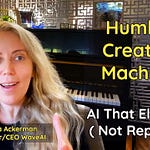While the tech industry chases AI billions with promises of artificial general intelligence and superintelligent machines, a different story is unfolding in the startup layer.
Entrepreneurs who focus on how people use technology are finding immediate success - not by selling AI dreams, but by solving real problems today.
Richmond Alake, part of MongoDB’s culture of entrepreneurism in employees says:
"You have to move fast, learn quickly, fail - and you're allowed to fail.
The key is learning from those failures."
This approach describes a new breed of AI entrepreneur who starts with human needs rather than AI First tech seen in many unicorns, seeing if AI can replace people.
As Amanda Slavin notes when questioning AI in education,
"The thing about AI is having the right information to feed AI.
When I ask big companies what they're doing, they talk about personalized learning - but what are you actually feeding it?"
These voices represent a quiet shift in how AI adoption happens.
While enterprise giants struggle with integrating AI and billion-dollar startups chase increasingly elusive valuations, small AI teams are earning trust through practical solutions.
What I’ve learned from them is trust, not technology, will be AI's true currency in 2025, and almost a first principle to gaining adoption, which is still slow.
From a non-profit to an AI SAAS company, the first focus again and again is on the people, the users, the customers, and not AI First.
How we fit AI into our lives will define the growth speed; that begins with trusting the AI, which isn’t evident in an early AI stuck between chatbots and fully automated AI Agents.
Sure it’s close, and it gets closer when respecting trust as a currency, an asset, and a defining line between success and failure in AI.
#1 AMANDA SLAVIN - LEARNING FREQUENCY
Learning Frequency chooses a different path as it starts: AI in education was focused on collecting data, not serving students.
Her team gives students control of their learning profiles through NFTs. Each profile captures not just academic performance, but learning styles, preferences, and needs.
When students change schools or teachers, they carry this information with them, sharing it on their terms. Teachers are prepped with resources to better understand a new student.
IN HER WORDS
• "When I've asked pretty big companies what they're doing in terms of measuring engagement, they're like, oh, we're using AI to create more adaptive and personalized learning - but how are you using AI?
What are you feeding it?"
• "These are small changes that can be made for every single student"
• "Help understanding how I learn helps me understand what I can do, not what I can't do"
• Empowers students to control their own learning data through NFTs
• Breaks down industrial-age education models
• Focuses on individual learning styles and needs
• Teachers quickly get up to speed with new students through shared profiles
COOL FACTOR
Learning Frequency flips traditional EdTech on its head. Instead of schools owning student data, students control their own learning profiles as NFTs.
When they move to a new class or school, they choose what to share with teachers.
This builds trust from day one and helps teachers prepare for new students before they even enter the classroom.
#2 RICHMOND ALAKE - MONGODB
MongoDB's approach to AI focuses on building trust from the inside out. Rather than treating AI as a technological overlay, MongoDB integrates it into their culture of rapid experimentation and learning.
Engineers are encouraged to try new approaches, fail fast, and share their learnings openly.
This transparency builds trust both internally and with customers, who see a company learning alongside them rather than claiming to have all the answers.
IN HIS WORDS
• "You have to move fast, learn quickly, fail - and you're allowed to fail"
• "The key thing is learning from those failures and using your learnings to inform your next action"
• "There is a lot of experimentation, lots of fun as well"
• Build AI culture through rapid experimentation
• Embrace failure as a learning tool
• Keep the human element in technical development
• Create safe spaces for effective testing and iterating
COOL FACTOR
MongoDB proves that large organizations can move like startups. Their approach turns traditional enterprise AI adoption on its head - instead of top-down implementation, they build from the ground up through employee experimentation and learning.
Employees become entrepreneurial within the company. Even the CEO can be reached in this non hierarchical tech business.
It’s like being part of a startup without risking your own capital and career. Instead of employees being told what to do, the team is encouraged to execute and improve.
#3 RICHARD WHITE - FATHOM
Richard White's journey with Fathom began as a personal frustration with Zoom meetings during COVID.
Instead of rushing to monetize yet another transcription tool, he focused on understanding how people record meetings with individual notes.
The discovery? Users need more than accurate transcripts; they need to capture and share the meaning of conversations.
By waiting two years to monetize, Fathom built such strong user trust that customers invested $2 million at the same terms as venture capitalists, proving that patient, user-focused development creates lasting value.
Customers investing in Fathom is trust literally as currency. Earned trust with lock in because Fathom makes you part of their business and product development.
IN HIS WORDS
• "We think transcription is going to become really cheap.
This is a product people were charging $150 a month for, but we're going to give it away for free"
• "I'm a big fan of delayed monetization because it's hard enough to get people to use the thing"
• "Working with models is very different from typical engineering projects.
Their output is not a feature, it has a failure rate"
• Focus on retention before revenue
• Build trust through actual usage
• Let customers validate your model
• Patient development creates deeper value
COOL FACTOR
White took the startup route of delayed monetization while building Fathom.
Instead of rushing to monetize, they waited two years to perfect their product.
The result? Customers believe so strongly, they invest $2M on the same terms as VCs (rarely done, as thanks) – showing trust creates earned value, and loyalty.
BARZAN MOZAFARI - KEEBO
Barzan Mozafari's Keebo challenges everything we think we know about enterprise AI adoption.
While most vendors talk about month-long implementations and massive change management, Keebo proves value in 24 hours.
How? By focusing on "high-value problems" - specific challenges where AI can demonstrate immediate impact. Keebo’s patented tech supercharges AI queries to the cloud, making it easy to setup and within a day see whether it’s saving you money.
This targeted approach builds trust through rapid results rather than lengthy promises. Keebo's 30-minute installation process isn't just a technical achievement; it's a statement about putting user needs first.
IN HIS WORDS
• "The AI adoption rate is disappointing.
The rate of progress in making AI machine learning is far surpassing the rate of adoption"
• "AI is a completely new beast to most enterprises.
They've been doing their business the exact same way for decades"
• "The CIOs have to think about security and privacy.
How do I know that my customer data is not going to end up somewhere in the LLM?"
• Focus on high-value problems (HVP)
• Prove value in 24 hours
• Make implementation effortless
• Address security concerns upfront
COOL FACTOR
While others talk about months-long AI implementations, Keebo installs in 30 minutes and shows ROI in 24 hours.
This isn't just speed - it's a fundamental rethinking of how AI should serve businesses.
MASSOUD ALIBAKHSH - OMADEUS
Massoud Alibakhsh's Omadeus takes a radical approach to AI architecture. Instead of building larger and larger language models, Omadeus creates small, focused AI agents with clear boundaries and specific purposes.
These "tiny LLMs" don't hallucinate because they're constrained by design - a perfect example of how limiting AI capabilities can actually increase user trust.
"Instead of shuffling dumb messages back and forth," Massoud explains, "you're exchanging intelligent objects that know their purpose and limitations."
IN HIS WORDS
• "We're using our own product to build our own product"
• "Instead of shuffling dumb messages back and forth, you're exchanging intelligent objects"
• "They're well programmed. They cannot execute more than these functions.
But they also can read and understand language"
• Small, focused AI agents outperform large models
• Clear boundaries build user trust
• Human control ensures reliable results
• Predictability beats raw power
COOL FACTOR
While the industry chases bigger AI models, Omadeus proves that smaller is often better. Their tiny LLMs can't hallucinate because they're designed for specific tasks - showing how constraints increase utility.
MEGS SHAH - PARASOL COOPERATIVE - CREATORS OF RUTH CHATBOT
RUTH began with a critical realization about tech abuse victims: tracking them, even to help them, could expose them to more danger.
While other AI projects focus on gathering more data, RUTH chose to protect users by not collecting their information in their product launch.
This common sense approach to user safety helped them scale to 29 countries in months, proving that sometimes the best use of AI is knowing when not to use it.
IN HER WORDS
• "We are very much survivor focused, and what that means is we try to take into account how would this make me feel if I was the one asking these questions?"
• "We need to be able to have it respond in such a way that it feels like you're talking to a friend more than a doctor"
• "The second piece is really to make sure that we're always making sure the end user feels safe"
• Privacy is a fundamental user right, not a feature
• Trust comes from protecting users, not tracking them
• AI can help without collecting personal data
• Safety and scaling aren't mutually exclusive
COOL FACTOR
RUTH proves that less data can mean more impact. By prioritizing user safety over data collection, they created a digital safe space that people – including advocates working to solve problems worldwide.
Their rapid scaling to 29 countries shows how putting user protection first creates organic growth through trust.
TRUST IS THE 2025 AI CURRENCY
These six entrepreneurs reveal a fundamental truth about AI in 2024.
While the industry chases billion-dollar valuations and artificial general intelligence, the best tech happens when we focus on human needs first.
• Start with users, not technology
• Build trust through immediate value
• Give users control of their data
• Focus on specific problems
• Small solutions often outperform grand visions
LOOKING AHEAD TO 2025
The next wave of AI success won't be measured in valuations but in trust earned.
Amanda Slavin's students control their learning data.
Richard White's customers become investors.
Barzan Mozafari proves value in 24 hours.
Massoud Alibakhsh constrains AI to make it more useful.
MongoDB's Richmond Alake shows how learning from failure builds lasting innovation.
In 2024 many in AI are acting like doctors – spouting complex technical questions without answers, asked of others who don't understand the question.
So many are caught up in predicting what’s going to happen in 5 years, that they don’t take care of people, employees, customers, all of us – right now.
These aren't the AI stories making headlines. You won't find these entrepreneurs promising AI to replace you or destroy you.
Instead, they're quietly solving real problems for real people. Real business solving real high value problems (HVPs)
AI integration happens when we find out how the technology works with people, not how it replaces them.
THE TRUST ADVANTAGE
Each of these entrepreneurs shows how trust compounds over time:
• Learning Frequency's student-controlled data
• Fathom's patient development approach
• Keebo's rapid value demonstration
• Omadeus's constrained, reliable agents
• MongoDB's culture of learning through failure
RUTH's project exemplifies this perfectly. By choosing not to track vulnerable users, they built enough trust to scale to 29 countries in months.
That's the power of putting people first.
It begins with users, listening to them, adapting to them, encouraging them, and building trust.
Trust is the new AI currency in 2025, money follows.


























